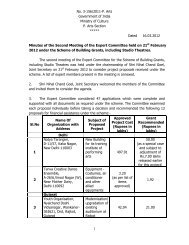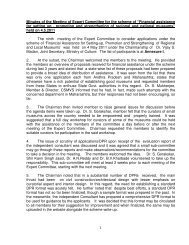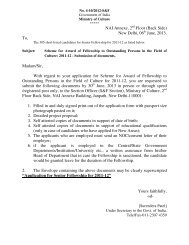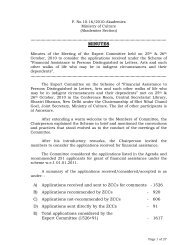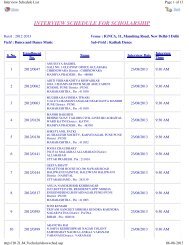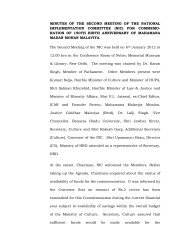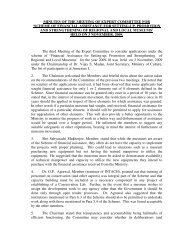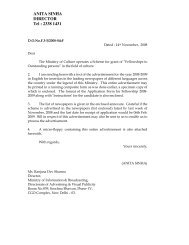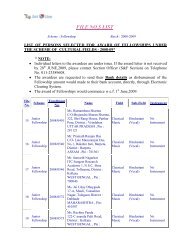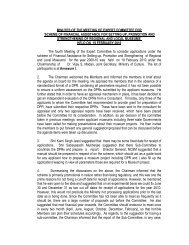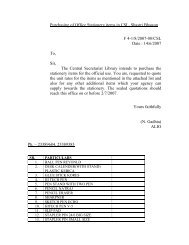Annual report - Ministry Of Culture
Annual report - Ministry Of Culture
Annual report - Ministry Of Culture
Create successful ePaper yourself
Turn your PDF publications into a flip-book with our unique Google optimized e-Paper software.
In course of exploration two low lying features<br />
(nullah) are noticed, which might have been created<br />
in the past by the rain water released from the<br />
cultivated lands situated to the west of the canal.<br />
Presently these are not in use.<br />
Southern Side<br />
In the southern area, settlement is found right from<br />
the shore and covered roughly 100 m of the total<br />
area of the proposed harbour site. Big boulders are<br />
put on the shore to arrest the soil erosion by PWD<br />
Department of Tamil Nadu Government It is worth<br />
mentioning here that in 1973 the Kannagi statue<br />
was installed on the shore of Poompuhar about 200<br />
m away from the high water line, and in 1994 it<br />
was shifted about 150 m inward because the<br />
structure was destroyed by the sea. Similarly other<br />
monuments at Poompuhar were also destroyed by<br />
the sea. (Underwater Exploration <strong>Of</strong>f Poompuhar<br />
and Possible Cause of Its Submergence,<br />
Aniruddha Singh Gaur and Sundaresh (p. 87,<br />
Purattava 28)). This area is totally bereft of any<br />
archaeological artifacts, only houses made by<br />
coconut leaves and some concrete buildings are<br />
noticed. Besides these, boats and Catamarans<br />
(Wooden boat) are kept there.<br />
It was also decided by the team leader that few trial<br />
trenches should be taken to ascertain the<br />
archaeological importance of the area. As such three<br />
trial trenches were taken, out of which, two were<br />
within the proposed harbour site and one was near<br />
the prawn cultivation area far from the harbor site.<br />
Trial Trenches at the site<br />
In the centre of the area, a Trench No.1 (11° 09¹<br />
092º N 79° 57¹ 406º E) measuring 2m x 2m was laid<br />
down for excavation. Excavation was carried out in<br />
an area of 2mX1m in the western half of the trench.<br />
It was excavated up to a depth of 1.10 m. Four<br />
layers of sandy deposits were observed in the section,<br />
compositions of all the layers are almost similar but<br />
they can be differentiated only by their colour and<br />
compactness which is due to the oil contents. No<br />
ANNUAL REPORT 2010-2011 21<br />
object of archaeological importance was found. At<br />
this depth water starts oozing up, so further digging<br />
was not possible.<br />
The Trench No. 2 (11° 09¹ 135º N, 79° 51¹ 421º E)<br />
was laid down in north-east corner of the proposed<br />
construction site, near the shore. Here also trench<br />
measuring 2m x 2m was laid. The eastern half of the<br />
trench was excavated up to a depth of 1.10m till the<br />
water was found oozing. In this trench two layers of<br />
sandy deposits were observed. Composition of both<br />
the layers is almost same but they could be determined<br />
only by their compactness.<br />
The third trench (11Ú 09' 30" N and 79Ú 51' 49" E)<br />
was laid out near the prawn cultivation area far from<br />
the proposed harbour site. The size of the trench was<br />
2m x 2m. This area is composed of soil and sand.<br />
Two layers are noticed during excavation. Till the<br />
depth of 50 cm no artifacts was found. It was<br />
excavated up to a depth of 1.25m, till the water was<br />
found oozing up. Two potsherds of red ware were<br />
found in layer 2. The thickness of the upper layer is<br />
about 60cm and composition is sand, while the second<br />
layer is compact and its composition is clay mixed<br />
with sand and contained potsherds. Its colour is muddy<br />
blackish.<br />
Findings<br />
In both the trial trenches laid out on the harbor site,<br />
no object/artifact of archaeological importance was<br />
noticed. However three/four different layers of sand<br />
differentiated by colour and texture were noticed.<br />
Different types of Mollusks and Shells are found on<br />
the shore.<br />
Observation<br />
It is observed that as no estuary is found nor any<br />
traces of the same is noticed anywhere in the proposed<br />
site at present, it might not be a port area of the<br />
ancient time. Estuary has a great help for safe<br />
anchoring and also for navigation of boats. Now the<br />
wave breaks at a distance of about 150m from the<br />
shore and it is not easy to cross this area.



